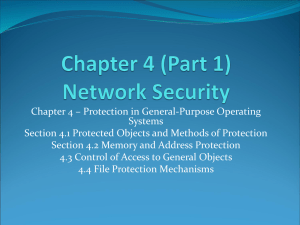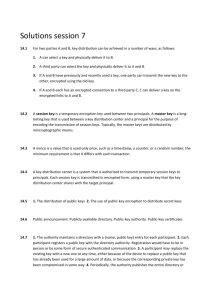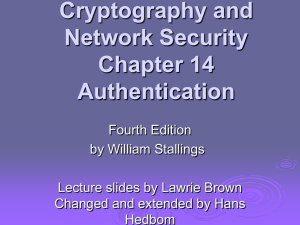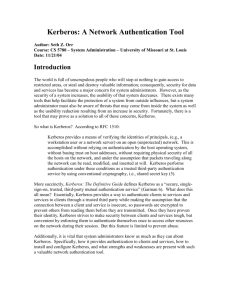Lecture 24
advertisement
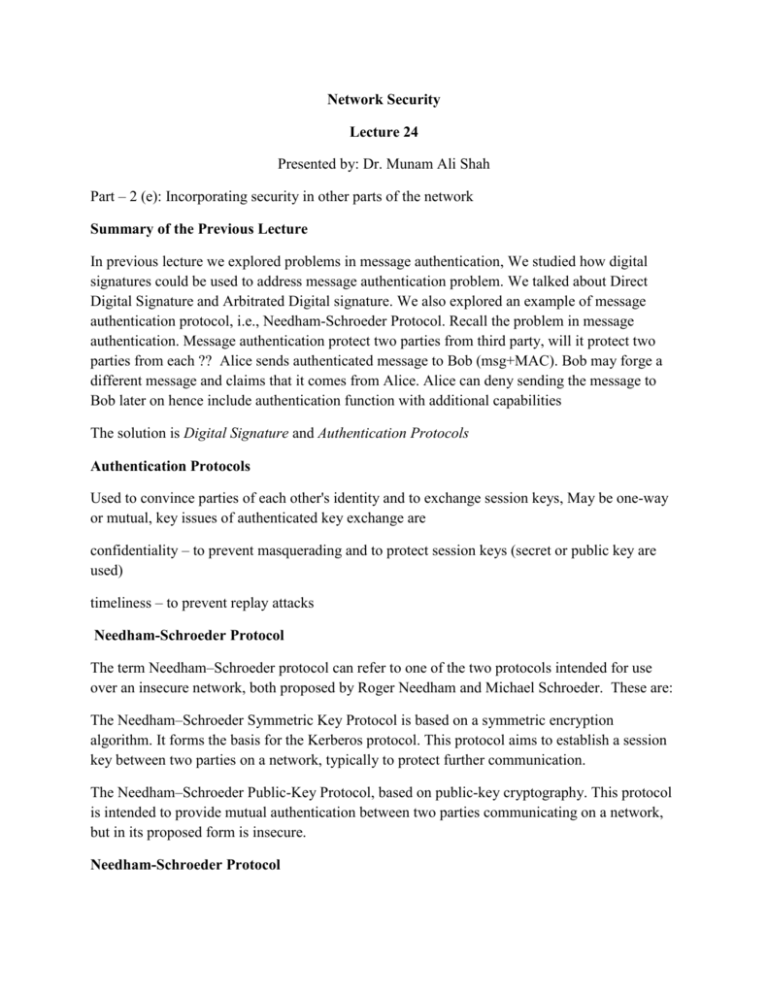
Network Security Lecture 24 Presented by: Dr. Munam Ali Shah Part – 2 (e): Incorporating security in other parts of the network Summary of the Previous Lecture In previous lecture we explored problems in message authentication, We studied how digital signatures could be used to address message authentication problem. We talked about Direct Digital Signature and Arbitrated Digital signature. We also explored an example of message authentication protocol, i.e., Needham-Schroeder Protocol. Recall the problem in message authentication. Message authentication protect two parties from third party, will it protect two parties from each ?? Alice sends authenticated message to Bob (msg+MAC). Bob may forge a different message and claims that it comes from Alice. Alice can deny sending the message to Bob later on hence include authentication function with additional capabilities The solution is Digital Signature and Authentication Protocols Authentication Protocols Used to convince parties of each other's identity and to exchange session keys, May be one-way or mutual, key issues of authenticated key exchange are confidentiality – to prevent masquerading and to protect session keys (secret or public key are used) timeliness – to prevent replay attacks Needham-Schroeder Protocol The term Needham–Schroeder protocol can refer to one of the two protocols intended for use over an insecure network, both proposed by Roger Needham and Michael Schroeder. These are: The Needham–Schroeder Symmetric Key Protocol is based on a symmetric encryption algorithm. It forms the basis for the Kerberos protocol. This protocol aims to establish a session key between two parties on a network, typically to protect further communication. The Needham–Schroeder Public-Key Protocol, based on public-key cryptography. This protocol is intended to provide mutual authentication between two parties communicating on a network, but in its proposed form is insecure. Needham-Schroeder Protocol Here, Alice (A) initiates the communication to Bob (B). S is a server trusted by both parties. In the communication: A and B are identities of Alice and Bob respectively KAS is a symmetric key known only to A and S KBS is a symmetric key known only to B and S NA and NB are nonces generated by A and B respectively KAB is a symmetric, generated key, which will be the session key of the session between A and B Used to securely distribute a new session key for communications between A & B It is vulnerable to a replay attack if an old session key has been compromised Modifications to address this require: timestamps (Denning 81), using an extra nonce (Neuman 93) (Both are improved protocols) Public key encryption Approches Have a range of approaches based on the use of public-key encryption, Need to ensure have correct public keys for other parties, Using a central authentication server (AS), Various protocols exist using timestamps or nonces. Denning Protocol In Denning 81, session key is chosen by A, AS just provide public key certificate, timestamps prevent replay but require synchronized clocks, One way authentication, Required when sender & receiver are not in communications at same time (e.g., email)., Have header in clear so can be delivered by email system, Email system has two requirements: Protected body contents: Email messages should be encrypted and mail-handling system should not be in possession of decrypting key , Sender authenticated: recipient wants some assurance that message is from alleged sender DSA Signature Creation To sign a message M the sender: generates a random signature key k, k<q , k must be random, be destroyed after use, and never be reused, Then computes signature pair: r = (gk mod p)mod q s = [k-1(H(M)+ xr)] mod q Sends signature (r,s) with message M DSA Signature Verification Having received M & signature (r,s) , To verify a signature, recipient computes: w = s-1 mod q u1= [H(M)w ]mod q u2= (rw)mod q v = [(gu1 yu2)mod p ]mod q If v=r then signature is verified Authentication Applications Kerberos Authentication service developed at MIT, Uses trusted key server system, Provides centralised private-key third-party authentication in a distributed network, allows users access to services distributed through network, without needing to trust all workstations, rather all trust a central authentication server, two versions in use: 4 & 5 Threat in distributed environment A user gain access to a workstation and pretend to be another user from that workstation, alter the network addr. of workstation, so that request sent will be appear from impersonate system, may evasdrop on exchanges and use the replay attack to gain entrance to the server or to disrupt the operations. Authentication at each server ?? Kerberos is used to authenticate user to servers and servers to users, Three approaches for security. Rely on client workstation to ensure the identity of its users and rely on each server to enforce a security policy based on user id. Require the client system to authentication themselves to servers, but trust the client system concerning the id of users. Require the user to prove its id for each service invoked. Also require that servers prove their id to clients Kerberos Requirements Its first report identified requirements as: Secure: opponent should not be able to get information to impersonate a user, Reliable: should be reliable and provides a distributed server architecture, Transparent: ideally user should not be aware of authentication service, Scalable: system should be capable of supporting large number of clients Kerberos v4 • 1. 2. 3. A simple authentication Dialogue CAS : IDC||PC||IDV ASC : Ticket C V : IDC||Ticket Ticket = E(Kv , [IDC||ADC||IDV]) • An opponent could capture the ticket and transmit it from different workstation, the AD (network address) is use to cop this problem • Two problem needs to be address – Minimize the No. of time user enter a password – Avoid plaintext transmission of password Kerberos v4 Dialogue 1. obtain ticket granting ticket from AS once per session 2. obtain service granting ticket from TGS for each distinct service required 3. client/server exchange to obtain service on every service request Vulnerabilities 1. Life time associate with ticket-granting ticket, small lifetime : user need to enter password repeatedly long lifetime : opponent has great opportunity for reply opponent copy the ticket granting ticket, waits for the legitimate user to logout , forge the legitimate user network address and send message of step 3 to the TGS, A network service (TGS) must be able to prove that the person using a ticket is the same person to whom that ticket was issued 2. Server to authenticate themselves to users, false server would be in position to act as a real server and capture any information from the user Kerberos requirements Kerberos server must have UserID and hashed password of all the users in its database, All server share a secret key with Kerberos server Kerberos Overview Kerberos v4 Message Exchanges, Authentication Service Exchange to obtain ticket-granting ticket, The problem of captured ticket-granting tickets and the need to determine that the ticket presenter is the same as the client for whom the ticket was issued. To get around this problem, the AS provide both the client and the TGS with a secret piece of information (Kc,tgs) in a secure manner. The client can prove its identity to the TGS by revealing the secret information, again in a secure manner. Authenticator is used only once and has short lifetime. TGS decrypts the ticket with key that it shares with the AS (Ktgs). Ticket indicates that user C has a session key Kc,tgs. The ticket says "Anyone who uses Kc,tgs must be C.“ The TGS uses the session key Kc,tgs to decrypt the authenticator C has a reusable service-granting ticket for V. Rationale for the Elements of the Kerberos v4 Protocol Message (1) Client requests ticket-granting ticket IDC: Tells AS identity of user from this client IDtgs: Tells AS that user requests access to TGS TS1 : Allows AS to verify that client's clock is synchronized with that of AS Message (2) AS returns ticket-granting ticket Kc: Encryption is based on user's password, enabling AS and client to verify password, and protecting contents of message (2) Kc,tgs: session key accessible AS to permit secure exchange between client and TGS IDtgs: Confirms that this ticket is for the TGS TS2: Informs client of time this ticket was issued Lifetime2: Informs client of the lifetime of this ticket Tickettgs: Ticket to be used by client to access TGS Kerberos Realms A Kerberos environment consists of: a Kerberos server; a number of clients, all registered with server; application servers, sharing keys with server; this is termed a realm typically a single administrative domain; if have multiple realms, Kerberos servers must have the user ID and hashed passwords of all participating users in its database. The Kerberos server must share a secret key with each server. The Kerberos server in each interoperating realm shares a secret key with the server in the other realm. The two Kerberos servers are registered with each other Kerberos Version 5 provides improvements over v4, addresses environmental shortcomings, Encryption Algo: v4 uses DES, v5 uses any encryption technique , Internet protocol: v4 uese IP address, v5 allows any addr. Types. Message byte order: v4 user define, v5 uses (Abstract Syntax Notation) ASN.1 & Basic Encoding Rules (BER) Ticket lifetime: v4 uses 8 bits (unit of 5 min) 28 *5 = 1280 min v5 includes start time and end time explicitly Authentication forwarding: v5 allows a client to issue a request to print server that then accesses the client’s file from a file server. Interrealm auth: v4 requires on order of N2 kerberos to kerberos relationships, v5 requires fewer relationships Technical deficiencies Double encryption: v4 ticket provided to client in message 2 and 4 are encrypted twice. v5 perform only single encryption. Non-std mode of use: v4 uses non standard mode of DES, v5 uses standard CBC mode . Session keys: v5 introduces the use of sub-session keys which is to be used only once per connection. Password attacks: both versions are vulnerable to password attack X.509 Authentication Service Defines framework for authentication services, directory may store public-key certificates with public key of user signed by certification authority uses public-key crypto & digital signatures algorithms not standardised, but RSA recommended. X.509 certificates are widely used. X.509 certificate associates public key with its user Public-Key Certificate Use X.509 Certificates issued by a Certification Authority (CA), containing: version (1, 2, or 3) : default v1, issuer unique id or subject unique id then v2, if one or more extension are present then v3, serial number (unique within CA) identifying certificate: signature algorithm identifier: algorithm used to sign the certificate, issuer X.500 name (CA): name of the CA that created and singed this certificate , period of validity (from - to dates). subject X.500 name (name of owner): the user to whom the certificate refers subject public-key info (algorithm, parameters, key) : public key of the subject issuer unique identifier (v2+): identifier used if issuing CA name is used for different entities subject unique identifier (v2+) extension fields (v3) signature (of hash of all fields in certificate): notation CA<<A>> denotes certificate for A signed by CA Obtaining a Certificate Any user with access to the public key CA can get any certificate from it , only the CA can modify a certificate because cannot be forged, certificates can be placed in a public directory CA Hierarchy If both users share a common CA then they are assumed to know its public key. Otherwise CA's must form a hierarchy, Use certificates linking members of hierarchy to validate other CA's , each CA has certificates for clients (forward) and parent (backward) . Each client trusts parents certificates . Enable verification of any certificate from one CA by users of all other CAs in hierarchy . CA hierarchy: How A obtains B’s certificate A obtains the certificate of X2 signed by X1. A obtains the certificate of B signed by X2. Since A has a trusted copy of X2’s public key so A can verify the signature and securely obtain B’s public key A uses a chain of certificate to obtained B’s public key X1<<X2>> X2<<B>> Similarly B obtain A’s public key in reverse order. Not limited to two chains Certificate Revocation Certificates have a period of validity May need to revoke before expiry, eg: 1. user's private key is compromised 2. user is no longer certified by this CA 3. CA's certificate is compromised CA’s maintain list of revoked certificates the Certificate Revocation List (CRL). Users should check certificates with CA’s CRL Authentication Procedures X.509 includes three alternative (all use public-key signatures) authentication procedures: One-Way Authentication Two-Way Authentication Three-Way Authentication Summary In today’s we talked about Digital signature and authentication protocols, The difference between Digital Signature Standard (DSS) and Digital Signature Algorithm (DSA) was also explored. We also studied Kerberos an authentication application Next lecture topics Our discussion on Kerberos will continue and we will explore its other versions, We will also discuss certificates and Certification Authority (CA). The End

